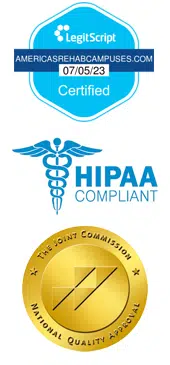 The Arizona Health Care Cost Containment System (AHCCCS, pronounced as “access”) covers a wide range of behavioral health services, including addiction treatment. If you have AHCCCS health insurance and need professional treatment for addiction, it’s possible your plan will cover some or all costs of the services you need at drug and alcohol rehab.
The Arizona Health Care Cost Containment System (AHCCCS, pronounced as “access”) covers a wide range of behavioral health services, including addiction treatment. If you have AHCCCS health insurance and need professional treatment for addiction, it’s possible your plan will cover some or all costs of the services you need at drug and alcohol rehab.
Keep reading to learn more about addiction treatment coverage under AHCCCS, and how to find out whether your health plan can help you pay for treatment.
About AHCCCS Health Insurance
AHCCCS is the name of Arizona’s Medicaid program. AHCCCS was founded in 1982 and provides coverage to more than two million Arizona residents. It covers several behavioral health services, including opioid treatment programs.
AHCCCS health insurance is accepted by many drug and alcohol rehab centers in Arizona, making it easy for state residents with Medicaid to get the help and treatment they need to successfully recover from their substance use disorders. Benefits and coverage levels are different for everyone based on their plan, so it helps to know which services you need and whether they are covered before choosing a provider.
Which Addiction Treatment Services Are Covered By AHCCCS?
AHCCCS provides coverage for addiction treatment services, including inpatient and residential rehab, intensive outpatient programs (IOPs), partial hospitalization programs (PHPs), and more. Fees and coverage for these services will vary from one AHCCCS member to the next based on their health plan and eligibility.
Medical Detox
Medical detox is included in most inpatient and residential rehab programs and is usually the first stage of addiction treatment for those who are physically dependent on alcohol, opioids, and benzodiazepines. Medical detox aims to reduce the severity of drug and alcohol withdrawal symptoms and prevent complications. The medications used in medical detox can help patients feel more comfortable as they recover from dependence.
The length of medical detox can range anywhere between a few days and several weeks. For example, medical detox for alcohol dependence can last two to 10 days, while detox for opioid dependence may last four to 20 days, reports the World Health Organization. Factors that can affect the length of detox include the type of substance that was being used and the severity of symptoms.
After patients recover from the acute symptoms of drug and alcohol withdrawal, many transition into a rehab program to receive behavioral therapy and counseling for addiction.
Residential Rehab
Residential rehab is ideal for patients who want to recover from addiction in a comfortable, home-like environment away from drugs and alcohol. This live-in recovery program can last anywhere between 30 days to 120 days or longer, based on the length of time the patient needs to learn skills that help them stay sober. Patients in residential rehab programs spend several hours a day receiving therapy and counseling and engaging in therapeutic activities that support recovery.
Residential rehab can benefit those who need a safe environment where they can focus completely on recovery without distractions or stress. This treatment program is also ideal for those who have struggled with addiction for many months or years, and who need help establishing a healthy and productive daily routine.
AHCCCS provides coverage for residential rehab, though the number of treatment days covered will depend on a person’s plan and eligibility.
Inpatient Rehab
Inpatient rehab is for patients who need 24-hour medical care and supervision due to co-occurring health conditions such as eating disorders and mental illness. Inpatient rehab programs are usually much shorter than residential rehab programs, as inpatient treatment aims to stabilize patients, avoid complications, and prevent them from harming themselves and others.
Substances including cocaine and methamphetamine can cause psychological withdrawal symptoms like aggression and paranoia. Patients with these symptoms are usually given sedatives to help them stabilize and relax. Patients with severe alcohol use disorder are at risk for a severe form of withdrawal called delirium tremens, which can cause seizures. According to MedlinePlus, delirium tremens is a medical emergency that requires hospitalization in an inpatient rehab program.
Outpatient Rehab
Outpatient rehab programs use a combination of services to help patients recover from addiction while they live at home or in a sober living facility. Counseling, behavioral therapy, and 12-step support group meetings are some of the many services included in outpatient rehab. AHCCCS provides coverage for several outpatient programs including PHPs, IOPs, and standard outpatient rehab.
PHPs offer the highest level of outpatient care. A PHP is also known as day treatment, and usually takes place four to six hours a day, five days a week. This outpatient program is ideal for patients who need several hours of therapy a day and can safely live at home without needing constant supervision.
An IOP is the next lower level of care after a PHP. IOPs take place for at least three hours a day on at least two days a week, according to the National Institute on Drug Abuse. These 12-week programs give patients more independence and flexibility to go to work or school or care for their families. Many drug and alcohol rehab centers that offer IOPs give patients the option to choose from a large variety of day and night classes.
A standard outpatient program takes place less frequently than an IOP and offers the lowest level of care. Standard outpatient rehab is ideal for patients who have already learned skills that help them manage triggers and stay sober. These patients may already have adopted structured daily routines and a healthy, sober lifestyle, but need ongoing support in the form of 12-step meetings, family behavior therapy, and medication management services.
Sober Living Home
AHCCCS may provide partial or full coverage for sober living communities. These homes are ideal for patients in recovery from addiction who may have been homeless, or who came from unstable living environments that exposed them to domestic violence, drugs and alcohol, and other stressful situations.
Sober living homes provide patients with a safe and highly supportive environment where all residents are in recovery from addiction. Residents are expected to adhere to house rules, such as nightly curfews and regular attendance at 12-step meetings.
Some sober living homes provide counseling and behavioral therapy services, as well as services like resume building and help with finding employment. Many sober living homes also provide residents with transportation to and from nearby drug rehab facilities where they can continue to receive outpatient treatment.
Medication-Assisted Treatment (MAT)
MAT is a treatment that combines the use of medications with counseling and behavioral therapy for people in recovery from opioid and alcohol use disorder. This “whole-person” approach to treatment is shown to help patients stay abstinent for a long period, and reduces the risk of relapse and overdose. According to the Substance Abuse and Mental Health Services Administration (SAMHSA), MAT is also shown to reduce criminal activity among illicit drug users and improve patients’ ability to gain and maintain employment.
The medications used in MAT can effectively reduce cravings for opioids and alcohol, and minimize withdrawal symptoms caused by these substances. MAT can be used in both residential and outpatient treatment programs. Cognitive-behavioral therapy, motivational interviewing, and contingency management are some of the many evidence-based therapies used in MAT programs.
AHCCCS covers the cost of MAT for many patients who are eligible to receive this treatment.
How Can I Check My AHCCCS Coverage and Benefits?
Addiction treatment is considered a type of behavioral health treatment and is covered by AHCCCS. However, the level of coverage is different for everyone based on their income level and other criteria.
One way to check your coverage and benefits under AHCCCS is to call AHCCCS directly at (602) 417-4000 or (800) 654-8713. A representative from AHCCCS can help you understand the benefits covered by your health plan.
Another way to check your AHCCCS coverage is to ask for help from your addiction treatment provider. Many drug and alcohol rehab centers will perform a free insurance benefits check for you to determine which services and treatments are covered by your plan. The advantage of checking your benefits using this method is learning your exact treatment options based on your coverage.
America’s Rehab Campuses has a treatment center in Tucson, Arizona that accepts AHCCCS. This treatment provider can quickly and easily verify your insurance benefits and coverage so you can receive treatment right away. Contact America’s Rehab Campuses at (833)-272-7342 to verify your insurance coverage.
What If AHCCCS Doesn’t Cover My Addiction Treatment Program?
If you’re still waiting for approval after applying for Medicaid benefits through AHCCCS, you may still be eligible to receive coverage for addiction treatment.
AHCCCS offers addiction treatment funding for injection drug users, moms with children, and pregnant women and teens who are still waiting for approval after applying for AHCCCS. All other Arizona residents with substance use disorders who are waiting for Medicaid approval may also be eligible to receive coverage for addiction treatment, as long as funding is available.
The above individuals may be eligible to receive MAT, residential rehab, counseling, and other services that support recovery. To learn more about your eligibility status, contact the AHCCCS Clinical Resolution Unit at (602) 364-4558 or (800) 867-5808 or speak to an America’s Rehab Campuses healthcare professional at (833)-272-7342.

